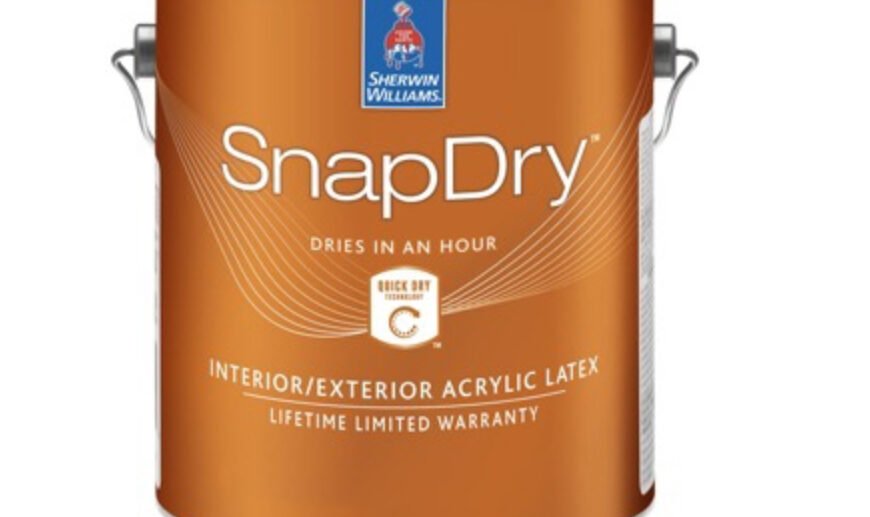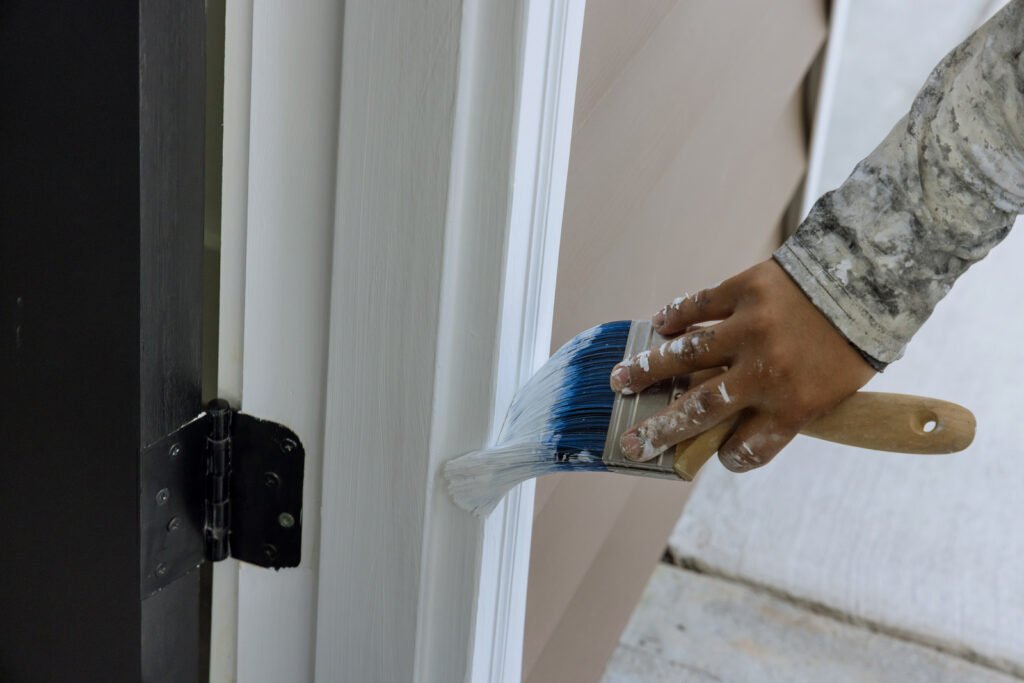A Guide On Choosing The Best Paint Finish for Trim and Doors

Table of Contents
ToggleWhen it comes to painting a room, selecting the right paint finish can make all the difference. While choosing the best paint finish for walls is important, it’s equally important to choose the right paint finish for trim and doors. The right paint finish can accentuate the details of the woodwork and give your space a polished, professional look.
The best paint for trim and doors will depend on a few factors, including the type of wood, the level of durability required, and personal preference. Generally, the most popular paint finishes for trim and doors are satin, semi-gloss, and high-gloss. Each finish offers different advantages and disadvantages, so it’s important to choose the right one for your specific needs.
Satin is a popular choice for trim and doors because it offers a subtle sheen that can enhance the natural beauty of the woodwork. It’s also durable and easy to clean, making it a practical choice for high-traffic areas.
Semi-gloss is another popular option that offers a slightly higher sheen than satin. It’s also highly durable and easy to clean, making it a great choice for trim and doors.
High-gloss is the shiniest finish option and is best reserved for those who want to make a bold statement. It’s highly reflective and can help to brighten up a space, but it’s also the most difficult to apply and maintain.
Understanding Paint Finishes
Types of Paint Finishes
When painting trim and doors, there are several types of paint finishes to choose from. These include gloss, flat, satin, eggshell, semi-gloss, and matte. Each type has its own unique properties, which can affect the overall appearance of the finished product.
- Gloss: This type of finish has the highest level of sheen and provides a glossy, reflective surface. It is highly durable and easy to clean, making it a popular choice for trim and doors. However, it can also highlight imperfections in the surface and may not be suitable for every application.
- Flat: This type of finish has no sheen and provides a matte, non-reflective surface. It is ideal for hiding imperfections in the surface and can be a good choice for walls and ceilings. However, it is not as durable as other finishes and may not be suitable for high-traffic areas.
- Satin: This type of finish has a low to medium level of sheen and provides a smooth, velvety surface. It is durable and easy to clean, making it a popular choice for trim and doors. However, it may not provide enough contrast to highlight architectural details.
- Eggshell: This type of finish has a low level of sheen and provides a soft, velvety surface. It is ideal for hiding imperfections in the surface and can be a good choice for walls and ceilings. However, it may not be as durable as other finishes and may not be suitable for high-traffic areas.
- Semi-gloss: This type of finish has a medium to high level of sheen and provides a smooth, reflective surface. It is highly durable and easy to clean, making it a popular choice for trim and doors. However, it can also highlight imperfections in the surface and may not be suitable for every application.
- Matte: This type of finish has no sheen and provides a flat, non-reflective surface. It is ideal for hiding imperfections in the surface and can be a good choice for walls and ceilings. However, it is not as durable as other finishes and may not be suitable for high-traffic areas.
Sheen and Light Reflection
The level of sheen in a paint finish can affect the way light reflects off of the surface. Glossy finishes reflect more light, while flat finishes reflect less. This can have an impact on the overall appearance of the finished product, as well as how well it highlights architectural details.
Selecting the Right Sheen
When selecting a paint finish for trim and doors, it is important to consider both the level of sheen and the durability of the finish. Glossy finishes may be more durable, but they can also highlight imperfections in the surface. Flat finishes may be better at hiding imperfections, but they may not be as durable. Satin and eggshell finishes can provide a good balance between durability and appearance, making them a popular choice for trim and doors. Ultimately, the right choice will depend on the specific needs of the project.
Preparation and Application

Surface Preparation
Before starting any painting project, proper surface preparation is crucial. This step ensures that the paint adheres well and the finish is smooth and long-lasting.
The first step is to clean the surface thoroughly. Use a vacuum or a tack cloth to remove any dust or debris.
Next, sand the surface with fine-grit sandpaper. Sanding helps to smooth out any imperfections and creates a surface that the paint can adhere to. For a smooth finish, it is recommended to sand between coats as well.
If the surface was previously painted, check for areas of peeling or chipped existing paint. These areas will need attention to ensure a smooth application later on. Use a scraper or sandpaper to remove any loose paint.
Painting Techniques
When painting trim and doors, it is important to use the right technique. One of the most common issues with painting trim is brush marks.
To avoid this, use a high-quality brush with synthetic bristles. Synthetic bristles are better at holding their shape and provide a smoother finish.
When painting, start at the top and work your way down. This helps to avoid drips and ensures that the paint is applied evenly. Use long, smooth strokes and avoid over-brushing. Over-brushing can cause brush marks and an uneven finish.
Choosing Brushes and Tools
Choosing the right brushes and tools is just as important as the painting technique.
For trim and doors, it is recommended to use a 2-inch angled brush. This type of brush allows for more precision and control.
When using oil-based paint, use natural bristle brushes. Oil-based paint can break down synthetic bristles, causing them to lose their shape and become less effective.
Best Practices for Trim and Doors
When painting trim and doors, choosing the right paint finish is crucial. Not only does it affect the overall look of the room, but it also plays a key role in the durability and maintenance of the painted surfaces.
Here are some best practices to consider when choosing the best paint finish for your trim and doors.
Durability and Maintenance
Trim and doors are high-traffic areas that are prone to dings, scratches, and scuffs. Therefore, it is important to choose a paint finish that is durable and easy to clean.
Satin, semi-gloss, and gloss finishes are all suitable options for trim and doors. Satin and semi-gloss finishes provide a good balance between durability and sheen, while gloss finishes offer the highest level of durability and shine. High-gloss finishes are not recommended for trim and doors as they tend to highlight imperfections.
Color and Aesthetic Choices
When it comes to color and aesthetic choices, white trim is a classic and timeless option that goes well with any wall color. However, natural wood finishes or colored trim can add interest and character to a room.
When choosing a paint finish, consider the overall aesthetic of the room and how the trim and doors will complement the walls and other elements.
Special Considerations for Areas
In high-traffic areas such as kitchens and bathrooms, it is important to choose a paint finish that can withstand moisture and humidity.
Satin, semi-gloss, and gloss finishes are all suitable options for these areas. However, in areas where there is a lot of natural light or where the walls are painted in a dark color, consider using a lower sheen finish to avoid highlighting imperfections.
Recommended Products and Brands
Top Paints for Trim and Doors
When selecting the best paint finish for trim and doors, there are numerous factors to consider. The right paint finish can make all the difference in the appearance and longevity of your paint job. Here are some of the top paint brands and products to consider for your next painting project:
- Benjamin Moore Advance: This alkyd enamel paint is popular among professionals and homeowners alike due to its durability and smooth finish. It is available in a wide range of custom-tinted colors and dries to a hard, furniture-like finish that resists chipping and peeling.
- Sherwin-Williams Emerald Urethane Trim Enamel: This high-quality paint is designed specifically for use on trim and doors, providing a durable, long-lasting finish that resists fading, cracking, and peeling. It is available in a range of colors and finishes, including satin, semi-gloss, and high-gloss.
- Behr Premium Plus Ultra: This paint and primer in one is a great option for those looking to save time and money on their painting project. It is available in a range of finishes, including satin and semi-gloss, and provides excellent coverage and durability.
Comparing Paint Brands
When comparing paint brands, there are several factors to consider. These include quality, durability, and price. Here are some of the top paint brands to consider for your next painting project:
- Benjamin Moore: This well-known brand is known for its high-quality paints and wide range of colors. Its products are popular among professionals and homeowners alike. The brand offers a range of finishes, including matte, eggshell, satin, semi-gloss, and high-gloss.
- Sherwin-Williams: Another popular paint brand, Sherwin-Williams offers a wide range of high-quality paints and finishes. This includes its popular Emerald line. The brand is known for its durability and color accuracy. Its products are available at a range of price points.
- Behr: This budget-friendly brand offers a range of paints and finishes, including its popular Premium Plus line. While its products may not be as durable as some of the higher-end brands, they provide excellent coverage. Behr paints are a great option for those on a tight budget.
In conclusion, selecting the right paint finish for trim and doors is a critical step in any interior painting project. As we’ve explored, each type of finish, from satin to high-gloss, has its unique advantages and characteristics, influencing both the aesthetic and functional aspects of the space.
Satin and semi-gloss are excellent choices for a balance of durability and subtlety, while high-gloss makes a bold statement and enhances brightness. Remember, preparation and proper application techniques are just as important as the paint itself for achieving a smooth, lasting finish.
Additionally, the choice of brand, such as Benjamin Moore, Sherwin-Williams, or Behr, can impact the quality and longevity of the paint job. By carefully considering these factors, you can ensure your trim and doors not only look fantastic but also withstand the demands of everyday use.

Hello, I’m Keith Jones. I’m the author and head of content here of door and window guide. I’ve been in the window and door industry for over 10 years in the UK and North America. I’ve had quite a few roles during my career mainly in Worldwide sales. I’m now semi retired so I thought I’d put my knowledge to good use educating people about all they might need to know about door and window related topics.





